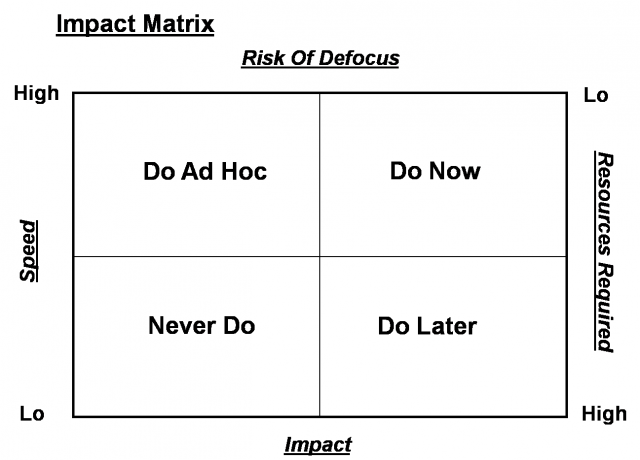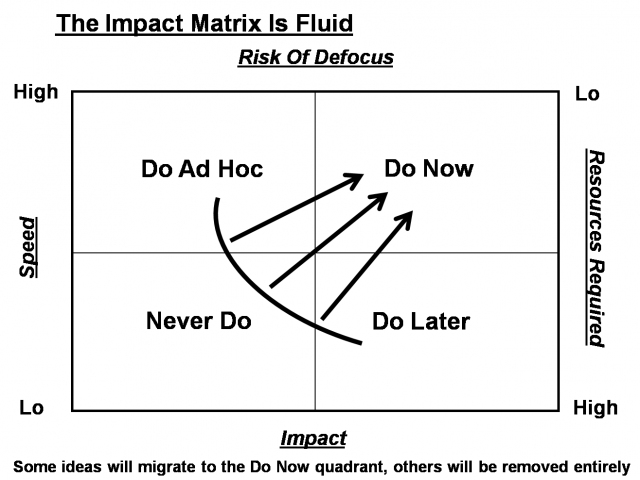 This article previously appeared in Forbes.
This article previously appeared in Forbes.
It is that time of year again - annual planning season. Dynamic, growing startups consistently identify more ideas and opportunities than they have the time or resources to pursue, including: entering into potential partnerships, developing new products and accessing emerging markets.
During my many years as an entrepreneur, I developed the Impact Matrix to help me prioritize such significant, long-term initiatives. I now use the Impact Matrix as a venture capital investor to help our portfolio companies objectively evaluate which initiatives they should pursue in the near-term, which they should re-considered in the future and which should be dismissed entirely.
If you haven't already subscribed yet,
subscribe now for free weekly Infochachkie articles!
The Impact Matrix
The ability to objectively critique and prioritize major initiatives is vital to an organization's long-term success. The Impact Matrix facilitates this process by quantifying the relative merit and priority of a proposed initiative. At larger companies, the Impact Matrix can be deployed at a departmental level, with each department’s projects eventually rolled up to a macro, company-wide view.
The criteria that comprise the Impact Matrix include:
Speed – How quickly will the ideas manifest themselves and begin to impact the venture.
Impact – The degree to which the ideas further the venture’s objectives. For instance, how much money will the proposed idea save the company or how much revenue will the potential opportunity generate?
Risk of Defocus – To what extent is the idea aligned with the venture’s overall vision. The less strategically congruent a particular idea, the greater the chance that its implementation will impede the company's ability to achieve its broader strategic goals.
Resources Required – At high-tech startups, required resources include developers’ time and the opportunity cost associated with alternative uses of the developers’ 12-hour workdays. Additionally, many opportunities require financial investments, which must be considered in tandem with non-financial resource requirements.
Once all the opportunities are mapped on the Impact Matrix, they can be visually compared with one-another, based on the quadrant in which they appear.
Each criterion is scored on a scale of 0 – 10. For instance, a particular idea might be quantified as follows:
Speed: 6 - relatively fast
Impact: 3 - relatively small
Defocus: 7 - relatively low risk (0 = deal with significant potential loss of focus)
Resources: 2 - relatively small
Total: 18 - mediocre, intermediate opportunity
The higher the overall score, the closer the initiative will appear to the upper right corner of the Impact Matrix and the higher it should be in the company’s implementation queue. In the above example, a score of 18 is a "Do Later" project: not high enough priority to merit immediately moving forward, although it warrants reassessment at a later date.
Implementing The Impact Matrix
Every organization has unique constraints and challenges. Thus, disregard any of the following suggestions for integrating the Impact Matrix into your organization that are not applicable to your venture.
- Menu – CEO defines the list of ideas and the opportunities to be evaluated, as well as the team of evaluators.
- Balanced Constituency – As detailed in Be The Beatles, an organization comprised of intellectually honest people who collectively have a balanced point of view will generally make sound decisions. You can reinforce the objectivity of the Impact Matrix process by including a cross-section of your organization on the evaluation team.
Engineers typically evaluate ideas differently than people engaged in sales, who in turn will consider ideas from a dissimilar vantage point from those responsible for product development, customer support and marketing. The prioritization process is more painful when all of your organization's constituents are included, but the resulting decisions are correspondingly more sound.
- Blunt & No Reprisals – Encourage participants to be straightforward and honest, without concern for hurting their peers' feelings. Everyone should understand that critiques are divorced from the person(s) supporting an idea.
- Majority – Allow all participants to evaluate each idea under consideration, irrespective of their title or status. Obviously, do not allow participants to evaluate their own ideas.
- Snooze and Lose – Participants not present are not allowed to subsequently vote. This ensures that all lobbying and discussions are performed in a single forum, thereby increasing the efficiency and transparency of the process.
- Veto – CEO retains the right to override the majority. However, to avoid undermining the democratic process, such vetoes should be rare. It should generally be deployed only when the CEO has sensitive information that is not known to the larger group.
Iterative Planning
An individual idea’s relative position on the Impact Matrix can shift over time, as shown below. For instance, in 2003, I lobbied for a Mac-compatible version of GoToMyPC. However, at that time, our resources were better applied to exploiting our primary, PC-based market.
You will probably never execute most of the ideas in the "Do Later" quadrant. In the case of GoToMyPC, a Mac-compatible version was not released until 2010, once the market conditions warranted a higher Impact Matrix score.
Quantified Scores Reduce The Emotion Quotient
Due to the high-drama endemic in a startup organization, it can be challenging to evaluate opportunities in a systematic and dispassionate manner. Utilizing the Impact Matrix enforces an objective discipline on business development deal junkies, commission-driven sales leaders and engineers engaged in product feature creep.





